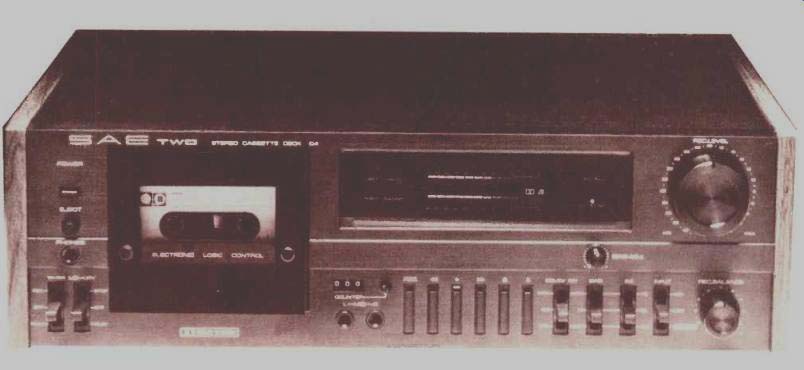
Manufacturer's Specifications
Frequency Response: 30 Hz to 14 kHz, 30 Hz to 18 kHz with high-output and with metal tape.
Signal/Noise Ratio: 55 dB, CCIR/ARM; 63 dB with Dolby NR.
Separation: 40 dB.
Crosstalk:-65 dB.
Erasure: 65 dB.
Input Sensitivity: Mike, 0.18 mV; line, 57 mV.
Output Level: Line, 350 mV.
Flutter: 0.08 percent wtd. rms.
FF & RWD Times: 70 seconds for C-60.
Dimensions: 18 1/4 in. (464 mm) W x 5 1/4 in. (147 mm) H x 13 3/8 in. (340 mm) D.
Weight: 20 lbs. (9 kg).
Price: $500.00.
The Model C4 stereo cassette deck is one of the SAE Two series of high-fidelity components. The manufacturer's stated philosophy on the introduction of this lower-priced line was to "combine the advantages of SAE's engineering preeminence with the efficiency of Japanese manufacturing." The front panel is a brushed, nonreflective black, with white designations for functions and switch positions. The combination is attractive and easy to read, in general, except with the lowest lighting levels. There are six, three-position toggle switches with spring loading and large handles, which are aids in making changes. The functions and settings are as follows: Timer/Rec-Off-Play, Memory/Stop-Off-Repeat, Dolby NR/Mpx-On-Off, Bias/Metal-Hi-Low, EQ/70-70-120, and Input/Mic-Line-Rec Mute. The timer function will certainly be helpful to some, and the inclusion of Repeat for memory adds convenience if there is any need to replay something, perhaps to check a recording just made. There is no bias-switch position for FeCr tapes, but there is a worthwhile bias-adjust pot, with the desirable center detent. The Rec Mute function removes the signal from the meters and the head phones, so monitoring must be done with the main system.
The record-level control has a very large, easily set knob and, with rotation, has the feel of a multi-step attenuator. There is also a level-balance control with a center-position detent. Metering is by bluish fluorescent bar-graphs, scaled from-25 to +5 dB, with Dolby level indicated at about +3 dB. Each bar has 12 double-segments to cover the range, with smaller steps around 0 dB. Tape-motion controls are all light-touch bar switches. Each one has a red status light at the top, with the exception o' Stop. The C30 remote control unit supplied with the deck repeats all of the functions, but it does not have any status lights. The logic allows switching among all of the modes, including going into Rec while in play or fast wind. This feature may not be used by some, but if there is a need for flying-start recording, the C4 has it.
The cassette carrier/door opens smoothly to provide excel lent access for cleaning and demagnetization. The push but tons for Eject and Power caused a little confusion as their shapes are not typical, and the designation "Eject" is closer to the a.c. switch than is "Power." There are phone jacks for mike inputs and for stereo headphones. The line-in/line-out phono jacks are on the rear panel, as is the socket for the remote control. Removal of the steel top and side cover (with wood end pieces) revealed one large p.c. board with smaller ones for logic, motor control, and power supply. The soldering was very good with very little flux residue. Parts were identified by number, although adjustments were not labeled with the functions. Most interboard connections were direct-wire soldered, with some multi-pin plugs. Four internal fuses were noted, all pigtail type and soldered in. There were two transformers, one quite large and one small. The lack of a schematic prevented determining the splitting of power functions between the two.
Performance
The first test made on the SAE Two deck was on playback response, and the playback responses were both very flat over most of the range, but were down 2 to 3 dB at the lowest and the highest frequencies. The meter indication for Dolby level was a dB low. In a record/play test with a 10-kHz tone, there was about 50 degrees of phase jitter, average for a cassette deck.
With the aid of a pink-noise source and a 1/3-octave RTA, about a dozen tape formulations were checked for performance. Maxell UD-XL I, BASF Studio II and TDK MA-R gave the best results with the C4, but Scotch Master I, TDK D, Memorex High Bias and Scotch Metafine were very close-particularly with the use of a little bias trim. Swept record/ playback responses were run at both Dolby level (200 nWb/ m at 400 Hz) and 20 dB below that. The results for the three tapes used are shown in Figs. 1 to 3 and in Table I. The figures are at least as good as the manufacturer's specifications, similar to those for other decks in the same price category. The responses in Dolby mode were very close to those without NR, better tracking than with quite a few decks. The bias control had a range of ±2.5 dB at 10 kHz with BASF Studio II. The multiplex filter was down 3 dB at 15.6 kHz and over 30 dB at 19 kHz. Bias in the output during recording was satisfactorily low.
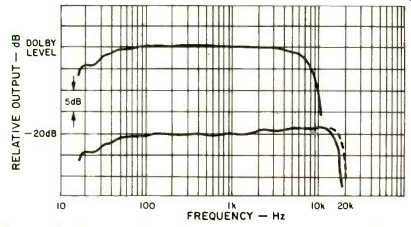
Fig. 1--Frequency responses in Dolby mode with Maxell UD-XL I tape. High-end
response without Dolby NR (dashed line).

Fig. 2--Frequency responses in Dolby mode with BASF Studio II tape. High-end
response without Dolby NR (dashed line).
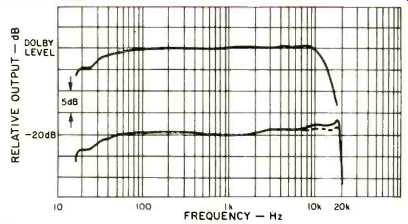
Fig. 3--Frequency responses in Dolby mode with TDK MA-R tape. High-end response
without Dolby NR (dashed line).

Table I--Record/playback responses (-3 dB limits). Table II--Signal/noise
ratios with IEC A and CCIR/ ARM weightings.
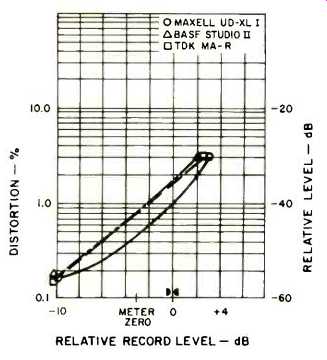
Fig. 4--Third harmonic distortion vs. level in Dolby mode at 1 kHz with
Maxell UD-XL I, BASF Studio II, and TDK MA-R tapes.

Fig. 5--Third harmonic distortion vs. frequency in Dolby mode at 10 dB below
Dolby level with TDK MA-R tape.
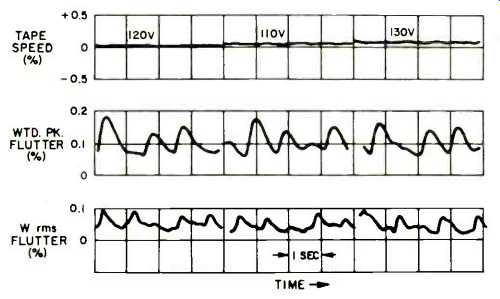
Fig. 6--Flutter (three trials) and tape play speed vs. line voltage.
Fig. 4 shows the results of measuring the level of the third harmonic distortion, HDL3, with the three tapes with 1 kHz at record levels from-10 dB re: Dolby level to the three-percent distortion limit. The lowest distortion was obtained with Maxell UD-XL I, and the results for the other two tapes match each other. The figures are to spec, and the associated, and quite good, signal/noise ratios are given in Table II. For distortion as a function of frequency, the results were typical at the lower frequencies, but much lower than most decks at the highest frequencies (see Fig. 5). With 1-kHz test tones, separation between channels was 44 dB, crosstalk was down at least 80 dB and erasure was greater than 80 dB, all excellent results. The erasure of metal tape at 100 Hz was about 70 dB, very good.
The input sensitivity on mike was 0.22 mV; that for line was 54 mV--both substantially to spec. Input overload points were quite high, 48 mV for mike and something over 29 V for line. Output level clipping first appeared as some flattening of the negative peaks of the test signal at around +10 dB relative to meter zero. The two sections of the level pot tracked within a dB from maximum down at least 50 dB, excellent performance. The output levels were 50 mV for headphones with an 8-ohm load and 380 mV at the line outputs, which dropped to 335 mV with the standard IHF load.
There was satisfactory volume with most headphones tried, although some were slightly low in level. The fluorescent-bar meters are scaled from "-25" to "+5" with single-dB steps from "-1" to "+1." All of the thresholds were accurate, much better than with most meters.
The response time was checked with a 5-kHz tone burst, and the attack time was actually on the fast side of the limits for peak program meters meeting IEC Standard 268-10. The decay time was much too short, being about the same as the attack time.
Tape speed at 120 V was about 1.3 percent fast, more than found with most decks. With changes in line voltage (Fig. 6), there was a slight increase in speed, but the speed was generally smooth. Typical values for flutter were 0.075 percent wtd. rms and 0.12 percent wtd. pk. There were fairly regular perturbations that caused momentary figures noticeably larger.
Wind times for a C-60 cassette averaged 68 seconds. The time from tape run-out to automatic stop was 3 to 4 seconds. Less than 1 second was needed to change wind directions, and just about 1 second to go from wind to play mode.
Use and Listening Tests
All required maintenance tasks were a snap to perform, even without removing the door/cover. Loading and unloading cassettes was simple, with a little care to ensure missing a little step inside the door. The great flexibility of the tape motion controls and the memory functions were used to ad vantage a number of times during the testing. It was hard to see the scales of the meters in a less-than-bright room, and the very rapid decay made metering difficult in trying to set maximum levels. All timer and memory functions worked as intended in a number of trials.
The instruction book is quite brief, but the text gets right to the point so the meat content is fairly high. There are few illustrations, and there is little detail in the ones provided. The suggestion of using FM noise and recording at-20 dB is a good one, but the user should adjust bias for the best listening results, as adjusting for the best level match flirts with sonic difficulties. A number of records were copied for comparison with playback: The New Brubeck Quartet, One Cut Above; Linda Ronstadt, Hasten Down the Wind; Hoist, The Planets with the Concertgebouw Orchestra with Neville Marriner, and others. The first attempts had some harshness at times, and there was some overload on the kickdrum on the Ronstadt disc. The conclusion was that the recording levels were somewhat high, and lowering them for the second trials gained improvements in all cases and resulted in good recordings. Stop clicks were a few dB out of tape noise, but record and pause effects were generally not discernible.
The C4 offers tape motion control flexibility that many other cassette decks do not, though it does not include mike-line mixing which could be important to some. Overall, the SAE Two C4 cassette deck will stand up on a comparison to other decks in the same price class.
-Howard A. Roberson
(Audio magazine, Feb. 1981)
Also see:
SAE Model 5000 Impulse Noise Reduction System (Equip. Profile, June 1977)
Sanyo Model RD5350 Stereo Cassette Deck (Feb. 1979)
Revox B710 MKII Cassette Deck (Mar. 1983)
Revox B225 Compact Disc Player (Sept. 1984)
= = = =